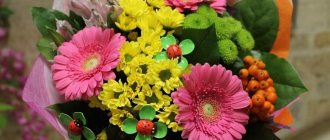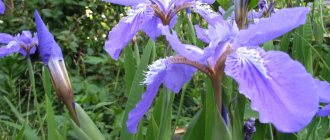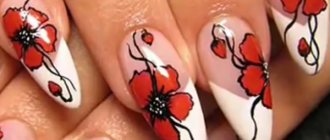Soft, sensual, touching, tender - all these are definitions of eustoma or lisianthus, if you remember the outdated name of the plant. Florists love these flowers for their high decorative and aesthetic characteristics: the bouquet remains fresh for up to 20 days, the stems are long and branched with several buds on each. Therefore, the compositions are lush and voluminous. Even 25 lisianthus is already a self-sufficient present.
History of the appearance of eustoma
The origin of the unique flower eustoma or lisianthus, as it is more often called in Russia, dates back to the 19th century, when the Englishman Richard Salisbury classified and named the flower.
The fate of the plant changed radically only in 1933 after the selection of new plant varieties in Japan. And from that moment on, it spread throughout the world. It is especially popular in many states of America, Mexico, and New Zealand.
The meaning of the eustoma flower lies in its name; the name comes from the Greek word “Eu” which means “beautiful” and “Stoum” - “mouth”, “mouth”. Fully translated as “lovely mouth.” And lisianthus, this is the second name, sounds like a blossoming or bitter flower.
In addition to the official names, the plant has many names from the places where it is cultivated: Japanese, American, Irish, mountain rose, prairie queen, Texas bluebell.
Initially, it did not have such bright colors and diverse shapes. However, breeders have developed flowers of all shades of yellow, lilac, peach, double, with a border and with a combination of several shades.
Meaning
According to an ancient American legend, lisianthus grew at the site of the death of a young girl who refused the warrior who proposed her hand and heart. The story is sad. Perhaps this is why the plant got its name - translated from Latin, Lisianthus sounds like a bitter flower. For the same reason, it symbolizes the beauty and purity of young girls. In Europe it is often considered a symbol of love and happiness. Combined with its natural beauty, the Irish rose becomes an ideal component for a bridal bouquet.
Interestingly, previously only blue eustomas were found in nature. However, many designers and decorators could not resist their beauty, so breeders had to develop plants that bloom in yellow, white, red and their shades. There is even a unique look - with contrasting edges.
White eustoma symbolizes love. Pink – tenderness. Lilac – sincerity and devotion.
How do florists use lisianthus?
The eustoma flower is very popular in wedding bouquets and compositions because it remains fresh for a long time and retains its presentation, in addition, it adds special meaning to the bouquet.
In the language of flowers it means happiness and joy, so it is an excellent addition to any holiday and for a romantic wedding celebration.
Many people are interested: what is eustoma a symbol of? It is associated with purity and innocence, it is presented on dates, it is used to decorate wedding arches and, of course, it is used to make bridal bouquets. After all, every girl dreams of having an exclusive look on her wedding day. The Japanese rose will add sophistication, lightness and tenderness to the bouquet and decorations; it goes well with other flowers, so you can safely experiment with it.
Types of bouquets in which eustoma can be used:
- Ball-shaped, good for young, fragile girls. Their sophistication and tenderness are perfectly emphasized.
- Cascading, similar to a waterfall, are formed from lilies, roses, and the Texas bluebell acts as an addition and background.
- Bibermeyer is the most common and classic type of bouquets. This composition is always small, round or oval.
Mono-bouquets can also be formed from the prairie queen. They turn out so lush and airy, they look good as a classic option, but they will also be appropriate for fashionable, stylized celebrations.
A monochromatic bouquet represents love and celebration. It is tied with satin, lace ribbons or regular twine. Here it is important not to overdo it with decor and glitter.
It is possible to form a composition from fully opened buds and not yet opened ones
Combination of lisianthus with roses
A common option for combining flowers in a bouquet with roses and eustoma, they look sophisticated and elegant. The classics include the combination of white lisianthus and red roses, see photo below:
Editor's choice: Spring-style wedding: a holiday shrouded in tenderness
A bouquet of spray roses and eustoma looks very beautiful.
For unusual compositions, you can take a combination of blue eustoma and white roses:
How to combine plants correctly in flower arrangements?
Magnificent bouquets are obtained from a tandem of roses and lisianthus. Plain colors will emphasize the tenderness and touching of the moment, and a combination of several shades looks impressive and original.
Together with freesia it brings lightness and airiness, looks good in photographs and looks non-standard. The bride's hair is decorated with freesia, and the plant stems are complemented with pearl beads and a beautiful ribbon.
The combination with alstroemeria is actively used by florists for fashionable stylish bridal bouquets. Plants complement each other perfectly and come in many color combinations, from pastel tones to the brightest colors.
Lisianthus looks great in pairs and complex compositions with callas, dahlias, chrysanthemums, gerberas and other large buds.
How to choose a bouquet
To choose the right wedding accessory, you need to study the features of two flowers in advance.
Follow our rules and you can buy a quality product:
- Don't take heavy bouquets. Choose options that you can easily carry all day. A wedding accessory should be small in size and, accordingly, weight. It would be completely unacceptable to look around at an armful of flowers.
- Ask your florist to choose flowers that do not have strong scents. Eustoma, unlike roses, has a muted scent. The royal flower, depending on the variety, can have a pronounced aroma. Try to avoid such options.
- For a more harmonious event, you can use flowers not only in a bouquet, but also as a designer decoration for the room and as an accessory for the bride’s head. Eustoma will look great on tables or woven into a girl’s wreath. As a result, you will be able to create a harmonious wedding.
- Don't be afraid to add additional flowers to your bouquet. But it is better that there are no more than 3-4 of them. Be sure to stick to the color palette.
Caring for the capricious Texas bluebell
It has rigid stems, and up to 30 flowers bloom in turn on each shoot. The cup is quite deep. The leaves are oblong with a bluish tint. The color is varied: shining white, all shades of pink, lilac, peach, burgundy, red flowers.
This overseas guest is a perennial under natural conditions, but gardeners care for it in the garden as an annual, and in a house, greenhouse or apartment they grow it as a perennial, it all depends on the gardener’s goals.
Many note that this American guest is quite finicky and difficult to care for.
Eustoma is a bright present on a gloomy day
The flower itself is very airy, trembling and bewitching. By giving such a bouquet to your significant other, you will not only express your feelings, but also remind her of the warm summer sun. And the most important thing is that it will delight you for a long time - up to 3 weeks! Like all spring flowers, eustomas have a delicate, subtle aroma.
The color range of eustoma is multifaceted. And the most interesting thing is that each shade contains a special meaning:
- White buds. A bouquet of white eustoma represents tenderness and admiration
- Pink – companions of sympathy and elegance
- Purple speaks of luxury, generosity and success
- And the blue ones are about passion.
Agricultural technology for seed germination
Seeds are sown starting in January. The seeds themselves are small and sold in the form of granules. They germinate rather poorly; 55-60% germination is considered a good result. The soil for germination should be light, not acidic. You can buy it ready-made, or prepare it yourself: mix garden soil, coarse sand and peat. The soil should be moist, the seeds should be spread over the surface, slightly pressed, and sprinkled with water on top.
Cover with glass or polyethylene, place in a warm and well-lit place, not forgetting to ventilate daily.
It is advisable to lower the temperature to 10 degrees at night, and add additional lighting during the day. The first shoots appear after one and a half to two weeks. From this moment on, water the seedlings less often and transfer them to a cool place.
When two leaves appear, they are cropped and transplanted into small separate pots, and after about 100 days they are transplanted to a permanent place on the site or into a pot using the transshipment method.
Mono-bouquet of plain eustomas
Plain bouquets of these flowers in the shape of a ball look elegant and discreet. When composing this type of bouquet, you should not get too carried away with decor, such as:
- ribbons;
- beads;
- sparkles.
Editor's choice: How to look good for a young mother: 5 ways to solve the problem
It is better if the stems of the composition are decorated with a satin ribbon, which will give the bouquet greater beauty and charm. Mono bouquets with unopened butanes look good, giving the composition as a whole a slight asymmetry:
Growing lisianthus in natural and indoor conditions
Growing on site
The optimal time for planting is early July. Leave a distance of 10-15 cm between seedlings, choose a bright place, without exposure to direct sunlight. Around the same time, the first buds bloom and continue to bloom until frost.
To preserve it in winter, you need to dig it up, plant it in a pot and move it into the house. The only drawback is the lengthy adaptation to the new place, it lasts almost a month.
Growing at home
The best place for the Irish rose is light eastern and western windows; it is advisable to place the pot as close to the glass as possible to ensure a day-night temperature difference. After waiting for the end of flowering, the “Texas bluebell” is dug up and thrown away.
Although eustoma is a rare guest in our gardens and on windowsills in apartments, interest in it is growing every day. This flower from America remains fresh after cutting for up to three weeks and pleases the eye for a long time with beautiful half-open buds, shaped like a rose.
With careful care, the capricious lisianthus, one of the most beautifully flowering crops, will give you its beauty all year round.
We learn about the secrets of growing eustoma by watching the video:
Eustoma or lisianthus are unusual flowers for festive moments.
Eustoma (lisianthus) is the most persistent flower.
This is a bush plant. Its elastic stems contain up to five already blooming flowers and buds. The main feature of eustoma is that with proper care, the buds gradually bloom. Because of this quality, the flower in the composition will retain its attractive appearance for a very long time. Buyers often call this plant a rose, and residents of some countries give it names such as bellflower and lisianthus. In order for a bouquet to delight you with its original appearance for a long time, it is necessary not only to choose it correctly, but also to know the nuances of its care. It is also worth considering the rules for creating floral arrangements with such a flower.
Planting in open ground
Cultivation of the plant in open ground is carried out every year, since eustoma grows outdoors only as an annual. In temperate climates, a flower can only be grown through seedlings, so they are grown in advance in the manner described above. You can also grow a flower by seed if you follow strict cultivation rules, but this process is quite complicated.
When to plant
The optimal time for sowing crops in open ground is considered to be mid-winter. In this case, the flowers bloom in mid-summer. In temperate climates, sowing is carried out immediately after the end of the cold weather and the soil has warmed to the required temperature. Seedlings are placed in open ground only in June or July, where they will begin to bloom almost immediately.
Where to plant eustoma
In order for the flower to grow normally, the choice of site is approached with great care. Flowers are placed in open areas, with no drafts and sufficient shading at midday. Gardeners do not recommend planting crops next to objects that reflect light.
As a site, choose a flower bed with a loose nutrient substrate and a high-quality drainage layer in the soil. The plant does not tolerate strong soil and air humidity, so planting is carried out in places far from groundwater and wetlands. Select areas with neutral soil acidity.
How to plant a flower
To plant eustoma indoors, it is enough to follow certain rules:
- the area is properly processed - they dig up and remove weeds;
- a planting hole for seedlings is dug in advance, it is watered abundantly, and a high-quality drainage layer of gravel, pebbles or expanded clay is created at the bottom;
- fertilizer for flower plants or nitroammophoska is poured into the planting hole;
- a layer of sand of about 5 cm is poured over the drainage;
- the seedlings are carefully placed in the soil in the center of the hole and sprinkled with nutrient substrate on all sides;
- After planting, the seedlings are watered.
You might be interested in: Lavrovishnya
When planting several eustoma bushes at the same time, gaps of about 20 cm are left between the crops. The soil around the plant is carefully compacted and then covered with a thin layer of peat - a mulched layer helps prevent complete drying of the soil and ensures poor weed growth.











